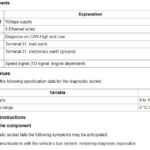Experiencing issues with your 2017 Alfa Romeo Giulia’s OBD2 system not being ready after recent service, particularly a software update recall? You’re not alone. It’s a frustrating situation, especially when it impacts your ability to pass emissions testing and renew your vehicle registration. Let’s delve into why your Giulia might be showing an OBD2 “not ready” status and what steps you can take to resolve it.
It’s common knowledge in areas requiring emissions testing that vehicles must have their On-Board Diagnostic (OBD2) system monitors in a “ready” state to pass inspection. These monitors are self-tests that your car’s computer performs on various emission control systems, such as the Evaporative System and EGR System. When these monitors are not ready, it typically means the car hasn’t completed these self-tests since the last time the Diagnostic Trouble Codes (DTCs) were cleared or the battery was disconnected.
In the case of a 2017 Alfa Romeo Giulia owner, a recent “complimentary recall” service involving a software update for turbo oil cooling seems to be the trigger for this “not ready” issue. After taking his Giulia 4Q to an Alabama dealer for the recall service, the owner encountered a failed emissions test in Tennessee due to “Monitors not ready” for both the Evaporative System and EGR System.
Alt text: Close-up of a 2017 Alfa Romeo Giulia dashboard highlighting the instrument cluster, used to monitor car status, relevant to OBD2 system readiness.
A technician at the emissions testing station suggested driving the car more, or consulting a mechanic or auto parts store for mileage information needed to reset the monitors. However, a local mechanic dismissed the idea of a specific mileage counter, pointing out that this issue is sometimes seen in newer vehicles. The mechanic recommended a driving routine: starting the car, idling in drive with the foot on the brake for five minutes, and then driving under 50 mph daily.
This advice is rooted in the concept of a “drive cycle.” A drive cycle is a specific set of driving conditions – varying speeds, acceleration, deceleration, and idling periods – designed to allow the OBD2 system to run all its self-tests. After a software update or battery disconnection, the OBD2 monitors reset to “not ready.” The vehicle needs to complete a drive cycle to reset these monitors to “ready.”
While there isn’t a universal “mileage” figure for completing a drive cycle, certain conditions must be met. These can include:
- Cold Start: Often, the drive cycle needs to begin with a cold start, meaning the engine has been off for several hours.
- Specific Driving Pattern: This usually involves a combination of city and highway driving, maintaining steady speeds, and allowing for deceleration and idling periods. The exact pattern can vary by manufacturer and model year.
- No Fault Codes: The absence of any active Diagnostic Trouble Codes (DTCs) is crucial. If there are underlying issues causing fault codes, the monitors may not set to “ready.”
Alt text: A detailed view of a 2017 Alfa Romeo Giulia engine bay, showcasing components relevant to emission control systems like EGR and Evaporative System, which are monitored by OBD2.
The mechanic’s suggestion of idling in drive and driving under 50 mph is a simplified attempt to initiate a drive cycle. However, for a 2017 Alfa Romeo Giulia, a more specific drive cycle might be required. You can typically find the recommended drive cycle procedure in your owner’s manual or by searching online resources specific to Alfa Romeo or Giulia models. Sometimes, Alfa Romeo dealerships can also provide information on the specific drive cycle needed for monitor readiness after service.
If simply driving according to a generic drive cycle doesn’t resolve the issue, it’s advisable to:
- Consult your Alfa Romeo Dealer: Explain the situation – OBD2 monitors not ready after the recall service. They should be familiar with post-service procedures and may have specific drive cycle instructions or diagnostic tools to expedite the readiness process.
- Professional Scan Tool: A mechanic with an advanced scan tool can check the status of the OBD2 monitors and potentially initiate specific tests or drive cycle modes.
- Check for Technical Service Bulletins (TSBs): There might be TSBs related to OBD2 readiness issues after software updates for your specific model year of Giulia.
The story of the Volvo customer waiting six months for monitor readiness highlights that complex systems can sometimes be stubborn. However, for a 2017 Alfa Romeo Giulia, a few proper drive cycles and potentially a dealer visit should be sufficient to get your OBD2 monitors in a “ready” state, allowing you to pass your emissions test and get back on the road legally. Don’t get discouraged; with the right approach, this issue is resolvable.
